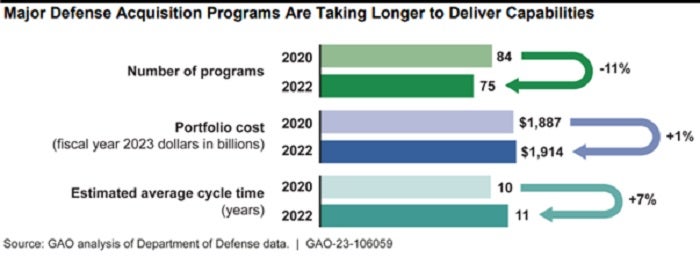A top priority of the Biden administration is to maintain a competitive edge over its adversaries when it comes to developing innovative weapon systems.
However, the US Department of Defense (DoD) cannot adopt new systems fast enough to maintain its desired capabilities.
The US Government Accoutnability Office (GAO) found that despite recent reforms in 2020 to revamp the acquisition process, the DoD continues to face challenges with adopting innovative weapon systems.
The GAO report, published on 8 June, assessed the performance of the DoD’s 101 costliest weapon programmes. It was found that supplier disruptions, software development delays, and quality control deficiencies led to programme decline. Additionally, these programmes continue to make investment decisions without sufficient knowledge, which can increase the risk of delays.
The US government’s weapons acquisition is currently on the GAO’s “high risk” list.
Failed reforms
From the DoD’s reports on their major defence acquisition programmes between 2020 and 2022, a number of programmes had declined. However, the portfolio’s total cost continues to increase, and the average planned cycle time to deliver operational capabilities shows new delays.
Net costs for the 32 major defence acquisition programmes that GAO assessed both this year and last year increased by $37bn. Rising modernisation costs, production inefficiencies and supply chain challenges drove the majority of costs.

Modular open systems approach
The GAO recommends that the DoD ensure that any new guidance and updates to relevant policies include details on when programmes using a “modular open systems approach” should complete verification testing.
A modular open systems approach helps the DoD keep pace with technology advances by adding or replacing components from a wepaon system once it is in the field. Most of the programmes reviewed reported using a modular open systems approach.
However, they did not consistently report planning to verify successful implementation of the approach before key points in the acquisition process, such as before beginning production.
Integration
Integrating components into a variety of systems has been on the agenda for a long time; not just for the US military either.
Nato is a strong advocate for greater integration between partners and allies. The war in Ukraine is a case in point. Boosting the chances of a successful counter-offensive does not end with a pledge for additional military platforms and artillery. Supporting forces have doinated a wide range of military platforms and capabilities for the Ukrainian Armed Forces. Not only do Ukrainian soldiers have to learn how to use these foreign, sophisticated weapon systems, but the grand array of different systems theyr ecieve leave no room for standardisation across the Armed Forces.
While advocating for greater modularity and integration across DoD systems would certainly help speed up its systems acquisition, modular integration is easier said than done.
Adopting this solution involves the private sector. Although the Biden administration has already stepped up efforts to support industry, it must also look to setting out a clearer requirements setting, which must include more modular components across its systems.
This is a difficult thing to achieve as the private sector currently drives innovation for the US military as companies design their own solutions. The government will now have to change the culture of its military-industrial complex if it is to truly take the GAO findings on board.











